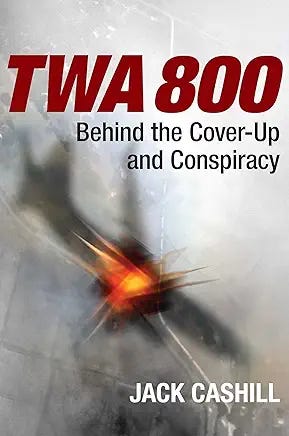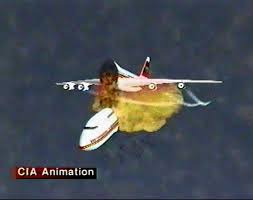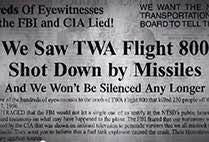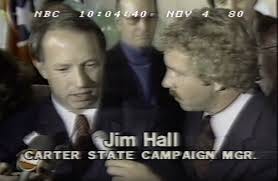Why the CIA Insisted a Mechanical Failue Destroyed TWA 800
And How Did the Agency Get Involved in a Domestic Airline "Accident"
On July 17, 1996, TWA 800, a Paris-bound 747, blew up ten miles off Long Island’s south shore, killing all 230 souls on board. In the days leading up to the anniversary, I will share some fresh insights on this tragedy and the much too successful cover-up that followed.
After 25 years dogging the TWA 800 case, I had a major EUREKA moment just yesterday. While recounting how the authorities used a dog training exercise to explain away the explosive residue found all over the plane, I had to ask myself a basic question: why did they feel the need to find an explanation for the plane’s destruction other than a bomb? Now I think I know. I should have figured it out a long time ago.
From day one, the FBI effectively scuttled all talk of missiles and sold the public on a bomb scenario, which, if nothing else, enabled Bill Clinton to appear presidential. On July 26, New York Times editors praised Clinton’s decision to install bomb detection systems in advance of any NTSB findings. On July 28, Times readers learned that “within days” the weight of the evidence would “prompt the Government to announce that the cause was sabotage, and that the case is being taken over by the F.B.I.”
The FBI felt confident enough to feed the New York Times its August 23 front page headline, "Prime Evidence Found That Device Exploded in Cabin of Flight 800." Now five weeks after the disaster, the case seemed to have been closed. There was no panic. Airports would screen a little more thoroughly. Life went on.
So why the change in direction? Enter stage left, the CIA. From day two, in seeming violation of its charter, the CIA was recruited to shadow the TWA 800 investigation. Officially, the FBI requested CIA help given “the possibility that international terrorists may have been involved.” The agency’s real task, however, was to suppress the true cause of the plane’s demise—a US Navy misfire. According to a CIA memo, “the DI [Directorate of Intelligence] became involved in the ‘missile theory’ the day after the crash occurred.”
CIA analysts quickly realized the scope of the problem. Thousands along Long Island’s South Shore had seen, in whole or in part, the plane’s destruction. In a July 30 internal memo, headlined “Hold the Press,” a CIA analyst warned of an impending FBI report on a likely missile strike. After interviewing 144 witnesses, the FBI was convinced there was a “high probability” that the incident was caused by a shoulder-launched surface-to-air missile.
According to the FBI three-man missile team, the evidence for a missile strike was “overwhelming.” The witnesses were “excellent,” and their testimony “too consistent” for the cause to be anything other than a missile. The unnamed CIA analyst boasted of how he discouraged the FBI from pursuing this angle. “I reported to [the FBI agent] the majority if not all our concerns, issues and problems with the determination that the incident was most-likely caused by a [missile].” Said the analyst of his FBI counterpart, “He had little to refute our concerns.”
At this point, even internally, all missile talk revolved around terrorism. The FBI agents appeared to be sincere in their beliefs; the CIA analyst knew better. In any case, the FBI never did go public with this report even though it had “only minor corrections left to make.” The future performance of the CIA suggests it played a role in suppressing it.
In this highly compartmentalized investigation, most FBI agents and NTSB staffers had no idea about the quality and quantity of eyewitnesses. The Times helped little, interviewing just one of the official 755 NTSB eyewitnesses. On August 17, reporter Andrew Revkin introduced Times readers to Witness 136, Michael Russell. On July 19, Russell told the FBI he was working on a survey vessel a mile off shore when “a white flash in the sky caught his eye.”
The FBI judged Russell’s story “credible” because it fit with the Bureau’s already skewed plot line. Russell caught the “white flash” out of the corner of his eye. He did not happen to see the ascending object that caused it. That said, the white flash suggested a high explosive, meaning one that detonates at a high rate of speed, as in a bomb or a missile.
The CIA analysts knew that there were hundreds more who saw the ascending object that caused the explosion. With the evolution of the internet—12 percent of Americans now had access—eyewitnesses were beginning to talk among themselves. The analysts knew that at some point authorities would have to explain away what these many “excellent” eyewitnesses saw, and a bomb wouldn’t cut it.
We know that as early as March 1997 the CIA had concocted its imagined scenario. Clinton political hack, the acting CIA director George Tenet, sent FBI director Louis Freeh a letter assuring him that “what these eyewitnesses saw was the crippled aircraft after the first explosion had already taken place.”
The agency’s quiet work behind the scenes culminated in the public premiere of a CIA produced animated video in November 1997. The FBI showed the video during a news conference announcing the suspension of its criminal probe. “Just after the aircraft exploded,” the narrator insisted, “it pitched up abruptly and climbed several thousand feet from its last recorded altitude of about 13,800 feet to a maximum altitude of about 17,000 feet.”
The animation showed the plane doing just that. As the narrator explained, when the nose of the plane broke off following a center fuel tank explosion, the sudden loss of mass caused the plane to turn up and climb. This rocketing, noseless 747 was what witnesses “repeatedly described as an ascending white light resembling a flare or firework.” The narrator then delivered his money quote. “What the witnesses saw was a Boeing 747 in various stages of crippled flight…The Eyewitnesses Did Not See a Missile.”
The CIA analysts almost assuredly imagined this scenario a month or so after the crash. They would have explained to their superiors that the mounting eyewitness accounts would have shown the bomb theory to be bunk. That theory had to be memory holed and quickly.
Four weeks after the Times seemingly definitive article—"Prime Evidence Found That Device Exploded in Cabin of Flight 800—The Feds shifted publicly to mechanical failure as explanation. They also shifted spokesmen away from the FBI’s Jim Kallstrom to the reliable NTSB chair, Jim Hall, an Al Gore crony whose “only transportation experience,” said one pundit, “apparently is a driver’s license.”
Although their leadership sold them out, many of the investigators resisted. The head of the FBI missile team, with whom I have communicated, fought the CIA and his own superiors to exhaustion. Several NTSB staffers have cooperated with independent investigators like myself and Tom Stalcup, but the CIA always had the upper hand.
Inexplicably, in 2008, the CIA’s Randolph Tauss went public with an authorized explanation for the agency’s involvement. According to Tauss, the FBI immediately requested CIA assistance given “the possibility that international terrorists may have been involved.” How then to explain the agency’s continued involvement a year after determining that an unfortunate mechanical failure destroyed the aircraft?
Aviation professionals, of course, would find the CIA mechanical failure scenario to be ridiculous, but it seemed plausible enough for a complicit media, a media that in the fall of 1996 had no greater task than to reelect a president.
Paid subscribers receive a weekly installment of my book-in-progress, Empire of Lies: Big Media’s 30-Year War on Truth, 1994-2024. Your support is much appreciated.








I happen to have some information regarding testing of one specific failure scenario, a short circuit/spark in a fuel pump. Sparks were actually induced in an operating pump submerged in fuel. The test result was negative, i.e. no ignition. I've never read the final report to see how specific it got beyond "mechanical failure."
Great work. As an early web user I remember having a photo saved that someone had taken showing the apparent missile contrail just before the incident.